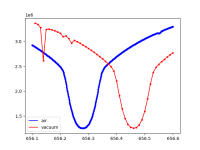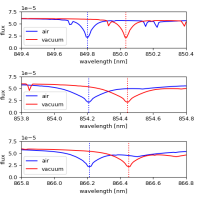-
Type:
Task
-
Status: Done (View Workflow)
-
Priority:
Normal
-
Resolution: Done
-
Affects Version/s: None
-
Fix Version/s: None
-
Component/s: None
-
Labels:
-
Epic Link:
-
Sprint:2DDRP-2022 E
AMBRE synthetic spectra are used for Yamashita-san's flux calibration, but their wavelengths are in air. They should be converted to those in vacuum.
[ambre_to_vacuum (Halpha).png]: You see the blue curve (AMBRE) has the H alpha line at 656.28 nm, which is in-air value. It should be at 656.46 nm, as in the red curve.
When λ_air is converted to λ_vacuum, the AMBRE synthetic spectra no longer have their sampling points at regular intervals. Down-sampling was formerly achieved by simply averaging neighboring bins, but it now needs a better resampling method. I interpolate the spectra with cubic splines, and integrate the cubic polynomials in each bin (scipy has this method).
I am not sure of this, but I assume that the AMBRE synthetic spectra are dE / dλ_air. It means that the spectra must be multiplied by dλ_air / dλ_vacuum.
[slant-bias.png]: Extrapolation (from 1200nm to 1300nm) was formerly done with a simple exponential function (black line). The red line is an AMBRE synthetic spectum to fit to. The pink region is not used in fitting, but is displayed for checking with eyes. You see that the fit would be improved with some slant bias c' + d'x (green dotted line), or the 2nd-order term in the exponential (blue line). I use the 2nd-order-term method (blue line) for extrapolation rather than the slant-bias method (green line) because the former involves fewer number of parameters.
[compare_5500_g_5_m_1_a_0.4.png] The new flux models look like the middle pane. You see that extrapolation is improved indeed, though most of the improvement is not due to the 2nd order term but to a better fitting algorithm.
The amplitude of the new flux models are 10^{32} times lower than the old ones because the new flux models are in erg/s/cm^2/Hz rather than nJy. I choose the former unit because the unit of flux models is not important anyway, and "10^{27}" as in the old flux models is so large that the values may be troublesome (flux^2 is infinity if flux is stored in float32).
I will replace the old fluxmodeldata package with the new one after I write a script to pre-compute broadband fluxes.



